In college, long before #GRWM, my friends and I had a litmus test to indicate an event’s importance: “Are you gonna Get Ready?” It was a weighted question that might be raised before the coffee shop, the house party, or The Wallflowers concert. Of course it meant a wardrobe change (likely a baby tee with denim overalls) and eyeliner application, but inevitably there was also some rummaging around for who-knows-what, and taking deep, exasperated breaths. It was as much about looking cute as it was about honoring the significance of the occasion. More ritual than preparation, we would lean in, meet one another’s eyes in the large mirror of the community dorm bathroom. Often, even if you weren’t attending the event, you’d be there for the Getting Ready: sitting on the sink counter, offering supplies, maybe feeling a little jealous or a little relieved. But either way, you showed up for support. What I’m saying is that I’m gonna Get Ready for this big hike. Thanks for being here with me.
(why?)
Those who know me best are not surprised. But when I’ve shared my plans with others, I’ve been asked “Like Eat, Pray, Love?” and “Have you always been such a free spirit?” And most frequently, with horror, “Alone?” (Answer Key: No. Aren’t we all? Yes.) I could be overanalyzing, but it seems that the follow up question, if not aloud, is otherwise evident: Why? Something must be wrong. Something must have happened. What are you running away from?*
I think it’s fair to wonder why. We humans seek out the familiar patterns, simplify them, and create stories. So here you go: Yes, there is a story here. Some things did happen, and oh yes, it’s plenty messy. Now suddenly, I’m leaving everything to do a 500 mile solo thru hike of the Pyrenees mountains. That’s all true. But what if I’m not running away from and instead, walking into? Perhaps I’m taking a pause in order to inhabit this moment fully; to confirm who I am in this, and walk intentionally through it.
Also, the trail is a really good place to cry.
The author concedes, at long last, to using trekking poles: Somewhere in Canyonlands.
If you’ve ever embarked on a long journey like this, you know that there’s often a catalyst. Still it’s never really about that thing, at least not for long. You walk off the sting of it sooner or later, and then it becomes about devotion. Pilgrimage. The honoring of some profound transition that you don’t yet understand fully. It’s about the way that life falls apart if you’re not holding too tightly, and about how that’s the best thing, dissolution. I don’t mean intentional destruction (although there’s a place for that too), but the acknowledgement of ruin: break-your-heart-open type of ruin. The courage to bear witness as all of the life-shards compost into nutrients. Do you know how gnarly it gets in a monarch chrysalis? Do you know about imaginal cells? If not, look it up! It’s like that.
You slow down and let that process work. Gestate. You move back into the heap of your body. You learn your feet again, re-learn the way they connect to the Earth. You remember the rhythm, the wisdom, the senses, the beauty; and then it becomes so normal (natural) that you don’t have to remember. You move with intention, and walking becomes meditation becomes wandering, in organic cycles. You think about food and water and rest, and you pay attention. There is a lot of discomfort to stay present with, and there is a lot of awe. It is deeply sacred. But it’s also thoroughly absurd and banal.
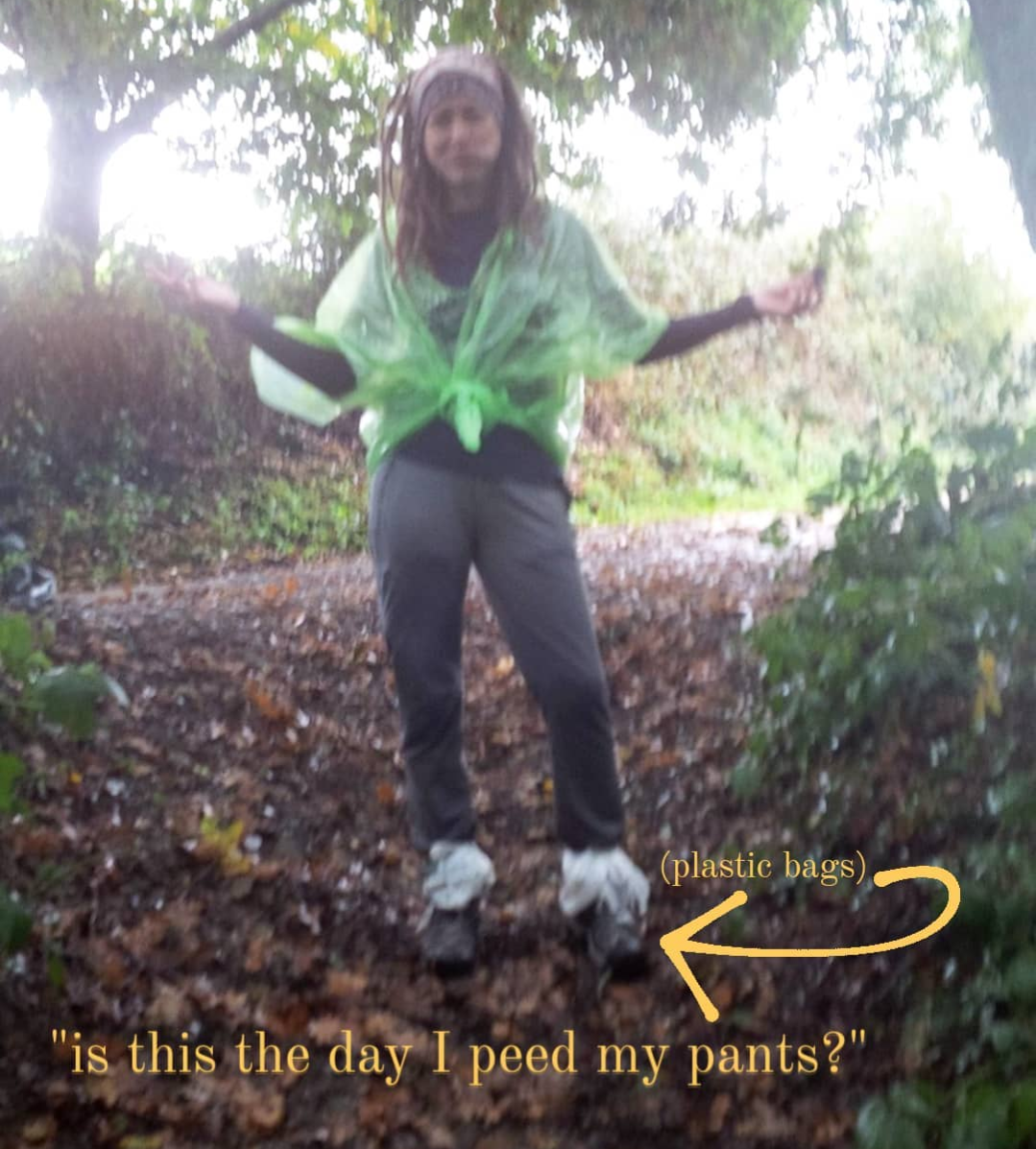
The author presents evidence in support of the contentious claim that the Camino is a thru-hike, snickers bar included. (The text “is this the day I peed my pants?” is an example of how desperately she’d dig for lost memories with her hiking partner years later.)
Right. Here’s why not: I’ve hiked 500 miles once before. Thanks to that experience, I suspect that I’m probably a little too thicc**, a little too old, and a little too inexperienced to thru-hike the HRP. At the very least, these 500 miles will not be nearly as gentle as the former, which were on the much flatter, more cafe- and hostel-dense Camino de Santiago. It was also twenty pounds and twelve years of this body ago! Because of that understanding (or in spite of it), I’m considering a few things more carefully for this trip, including:
- Planning
- Physical Training
- Gear
- Remembering
- Leaving, Returning
PLANNING (ish)
The Haute Randonnée Pyrénéenne (HRP), aka Pyrenean High Route, aka Haute Route Pyrenees, is more of an idea than one specific footpath. (To pronounce it, think of how you say the haute in haute couture–kind of like “oat.”) It is an approximately 500 mile (800 km) traverse along the spine of the Pyrenees mountain range, with over 167,000 feet total elevation gain and the same amount of elevation loss. (For reference, Mount Everest is 29,035 feet tall.) It typically takes around 6 weeks to hike and much of the route is unmarked. Beginning at the shore of the Atlantic Ocean and ending at the Mediterranean Sea, it weaves through Basque country, France, Spain, Catalonia, and Andorra. From sea to shining sea, if you will!
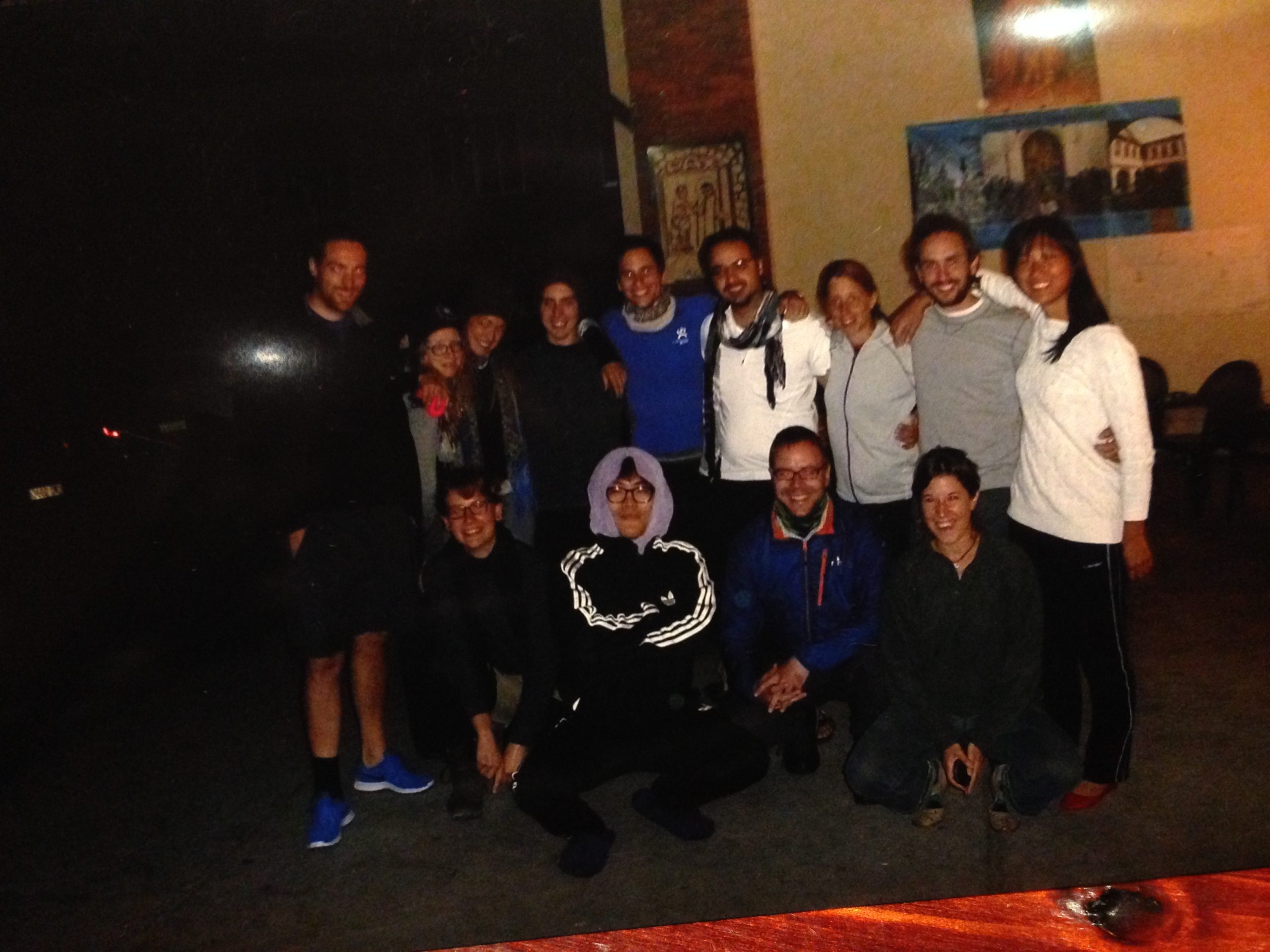
The author was the only American in this 2013 Camino Trail family, which included pilgrims from Sweden, Canada, Spain, Iran, Finland, Mexico, South Korea, Belgium, Italy, and Germany. She finds this ratio of American to non-American to be ideal.
There are two other trails that take similar paths through these mountains, but return more frequently to a lower elevation: the GR 10 (on the French side) and the GR 11 (on the Spanish side). The GRs (Grand Randonnees) are Europe’s well marked long-distance footpaths. The HRP has its own variants, meanders between the GR 10 and the GR 11, and sometimes follows one or the other. This makes alternate routes abundant, and I plan to take these variants often, either to avoid a difficult or more technical pass, for weather, or just because I feel like following a blazed path! There are also quite a few variants and side quests for those who consider themselves peak-baggers, which as of this writing, does not at all describe me.
I don’t really know what I’m doing. I mean that as a confession and as an intention. I’ve done solo backpacking and I’ve done solo international travel. I can speak a little French and a little Spanish, and can say eskerrik akso at the appropriate times in Basque country. I read a weird novel set in the Pyrenees. But the pre-trip anxiety is building quite spectacularly: Who do I think I am, in over my head, guilt and fear and fall-off-of-a-mountain, etc. In a way, though, I’m grateful for the space this anxiety has afforded me. The flights I’ve booked give me a cushion of two weeks in addition to the six weeks that I hope to finish the trail in. This gives me space for jet lag, travel, weather delays, zero/rest days, injury, and whim.
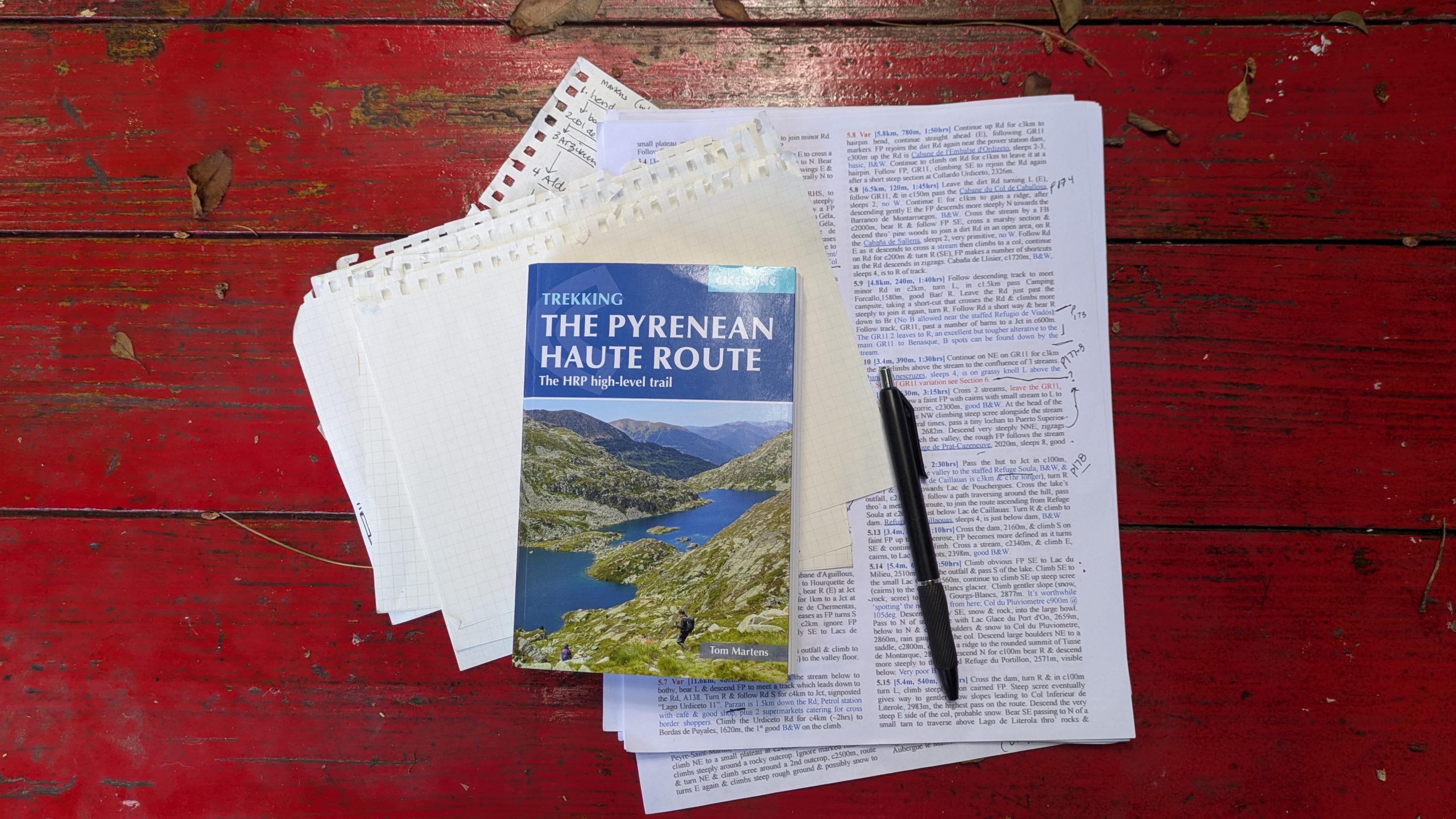
I want to leave space for wandering, following what feels good, making mistakes, and curiosity. So on purpose, I don’t know exactly which combination of routes I’ll end up following, or if I’ll even get all the way to the Mediterranean on foot. But yes, dad, I do have maps. I’ve been studying the Tom Martens Cicerone guidebook and Paul (Whiteburn) Atkinson’s HRP pocket guide, and I’ll carry paper copies of each. The GPX points are in my Caltopo app (and Gaia? Not sure which I’ll use), and I’ve got the Meteoblue app for weather. I have a Garmin inReach device and one of its more painfully expensive plans, not only for emergencies, but to send messages and check-ins and receive frequent weather updates via satellite. Resources that have helped me compile these things include Kelly Floro’s Trek blogs, random trip reports around the internet, and these facebook groups: Backpacking in the Pyrenees including GR10, GR11 and HRP & Pyrenean Haute Route (moderated by Tom Martens).
TRAINING
I don’t intend self-deprecation by acknowledging that I’m not as fit as I used to be. While I don’t see this as a barrier, it is certainly a challenge. I love my strong and capable body, the wisdom of 48 years and the power of four childbirths, but she’s gonna struggle to climb mountains. There are a few ways that I’m trying to support her, in the limited time I have before leaving.
Yoga. I’ve had a consistent hot power yoga practice for over a year and a half, attending class nearly every day. Turns out that when you practice a combined series of balancing postures like garudasana to standing leg raise to warrior 3 to needle to half moon a few hundred times, you build a great deal of joint stability, mobility, and deep core strength. The HRP plan is recent, but I love knowing that all this time I’ve been accidentally preparing to support my knees (and ankles and etc)! Recently, I had to take out the arch support I’d used in my running shoes for years. Yoga has changed my foot shape and the way I connect to the earth. The style of yoga that I practice also has a cardiovascular element. I’m also hoping that a daily workout in a 95-102 degree (F) room is going to help me acclimate to that inevitable Iberian August heat.
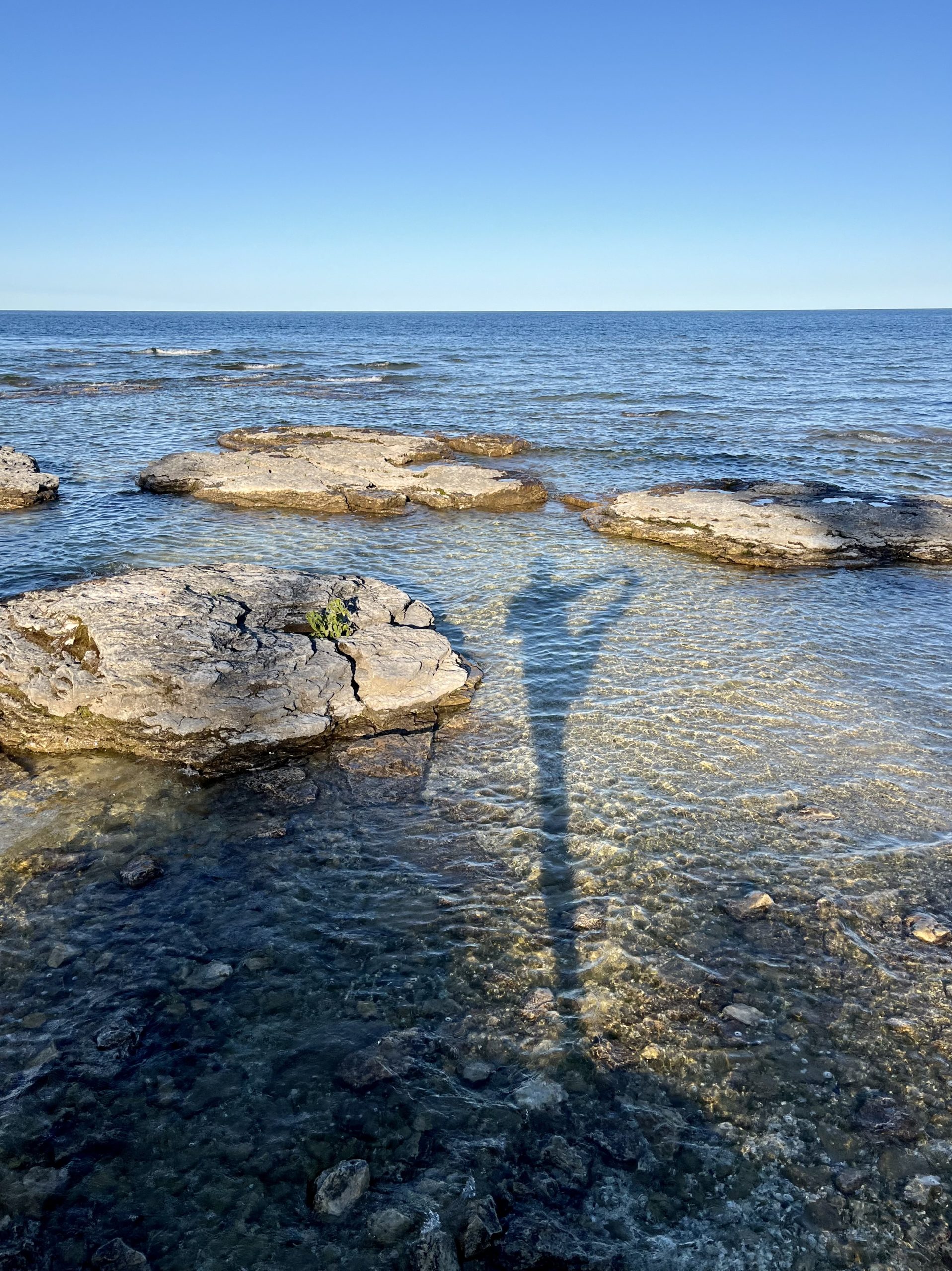
Lake Michigan Shenanigans
Breath. Integrated into any good yoga practice is pranayama, or focused breath work. I use it not only in yoga, but also in meditation, for my own mental health, and in my work as a midwife. This Winter, I read James Nestor’s Breath: The New Science of a Lost Art, and totally geeked out about the whole thing. I usually struggle to adapt to hiking at altitude, so I’ve been playing around with some of the techniques I’ve found to try to increase my carbon dioxide tolerance (like VIHT or Wim Hof). It’s so super weird and we’ll see if it helps! 4-7-8 breathing is my favorite overall default, with breath restriction/holding and slow, long exhales.
Knees, etc. I’m not a big fan of pharmaceuticals, but I became well acquainted with vitamin I (sad/cute hiker terminology for ibuprofen) fairly early in my hiking experience. Aside from the Camino, that experience generally includes much shorter backpacking trips and day hikes. My knees tend to talk to me about any elevation gain–they always have. So, I expect to hear from them more than ever. While I’m still home, I’ve been doing sets of leg stuff throughout the day: bulgarian split squats, lunges, step ups, (& down), calf raises, and whatever new technique I’ve found free from online hiker fitness folks. And I will be packing lots of ibuprofen and leuko tape.
Cardio. Not a ton, honestly. My perspective is that at my age, my mom was running marathons. I’m not there (23.4 miles short, in fact), but I do run a few times per week, lately. It’s a very slow, very easy jog: 3 minutes of jogging and 1 minute of walking (those intervals are a recommended strat from said mom!) for about a half hour. I don’t expect this to be adequate training, but it’s something.
GEAR!
Gear talk is weird and precious and silly. But choosing the only material things that you’ll be connected to for many weeks or months is such a glorious task! It makes you rethink everything you own and everything you think you need. For a good long while, much of the gear in my backpacking kit was from the late 90s, when I would absentmindedly cram 50 pounds of junk into a heavy Jansport backpack (which the salesperson at the Jansport Outlet was very excited about: one of the new “internal frame” packs!). I don’t meet “ultralight” criteria, but I’ve been working to bring my base weight down to about 13 pounds. I’m still playing around with it, but you can find my gear list here.
Much of my move toward a lighter pack has been the switch from a free-standing tent to a Durston trekking pole tent, and exchanging my beloved Nemo Disco 15 sleeping bag (which I will 100% continue to use for cold-weather camping because it’s a fluffy cozy dream) for an Enlightened Equipment quilt. I tried to tell myself that I wanted a Gossamer Gear Mariposa backpack for the 9 fewer ounces, but honestly, it’s because I don’t like the yellow USA-outdoor-chain-store vibe. But that chain-store bag the color of breastfed newborn poop is, unfortunately, just so darned comfortable that I couldn’t make the change in the end. I’m forcing myself to accept it, and its additional weight, by drawing on it with a sharpie, and telling myself I can try to make my own custom pack after this hike.

The author pretends to enjoy a 10 liter water carry through the Canyonlands Needles District, wearing old boots with no tread and the yellow pack in question.
It can get really pricey to analyze each item, and I expect to leave with a less-than-perfect system. I’ve still got a few things arriving in the mail and several things to return to the internet from whence they came (I cannot find the perfect tshirt/shorts/bra to wear for two months straight). I’ve also switched at last from boots to trail runners. Other things I’m unsure about carrying include my tevas (or make my own lightweight camp shoes from one of the panels of my Gossamer Gear ThinLite pad?), my microspikes (or presume I’m going late enough and early enough in the season to avoid snow?), a sleeping bag liner (or what about a pretty silk scarf?), and however many ounces of sketchbook paper.
REMEMBERING
It seems, now, like such a long time to be walking. I also know that it’s going to pass quickly and that I’m going to forget most of it. Memory is a flawed narrative, a practiced and curated story about something that no longer exists. In a mental game of uncanny valley telephone, the stories that we tell become the actual memory and replace the truth. And recording instead of being fully present, in an attempt to retain a future memory, ends up stealing from experience. I don’t want to see the giant mountains at my feet through the tiny screen in my hands or miss a genuine connection with a human for the sake of snapping a photo or secretly recording a voice memo. But I do really, really want to remember it. I don’t know where the balance is, but I’m not carrying a fancy (heavy) camera.
This is one of the worst parts about doing something like this alone. Nobody to help confirm it was real. I will be blogging here, and I hope that this space will keep me accountable to documenting and journaling, at least a little. I hope to do some sketching. I don’t expect to be terribly active on Instagram, but I’ll try to reacquaint myself with that place when I’ve got WiFi. And I do have an embryonic hope of creating something out of the story of the trip, flawed narrative and all! I imagine a long, tedious work of drawings and words: A graphic novel about a thru hike? Love? Grief? Birth? Art? Nature? Connection? Blisters? Who knows!
LEAVING, RETURNING
A part of planning to leave is planning to return. There is the mess and nuance of life, but I am privileged to have a safe place to come home to, and loving people who support me to do this. It is an obnoxiously irresponsible trip for me, financially and otherwise. As a midwife, I am on call 24/7 for several months, if I have any clients in my care. So taking time like this has meant relying on support from other midwives in my community, and turning away clients. I don’t know “what’s next” looks like in many aspects of my life, but honest, clear conversations with the good, beautiful people in my life have helped me to feel a little better prepared for it.
I leave in a few days. It’s the top of the roller coaster now, when the click-clacking slows to a stop because all that’s left is gravity. I’m thinking unfinished, mangled thoughts like: Courage and receptivity. Earth and flesh and fluid. Foxes and ounces and heartache. Allons-y and ultreia y suseya.
*My therapist says it’s not escapism. Sure, she happens to be hiking the Camino de Santiago right now but that’s just a coincidence!
**Apologies to my kids for saying “thicc”
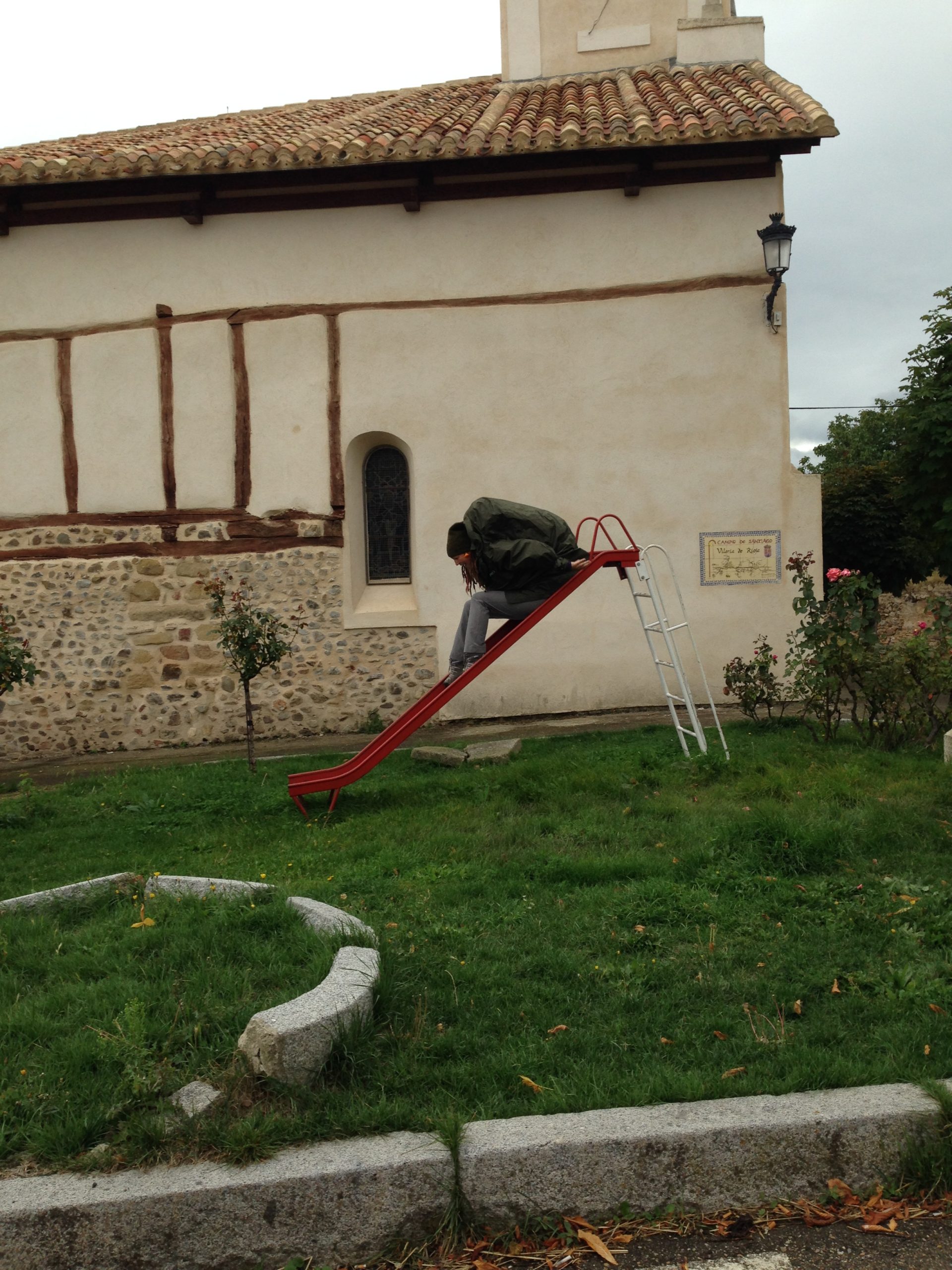
In sharpie, on a wall near the end of my camino:
And what you thought you came for
is only a shell, a husk of meaning
from which the purpose breaks only when it is fulfilled
if at all. Either you had no purpose
or the purpose is beyond the end you figured
And is altered in fulfillment.”
― T. S. Eliot, Collected Poems, 1909-1962




